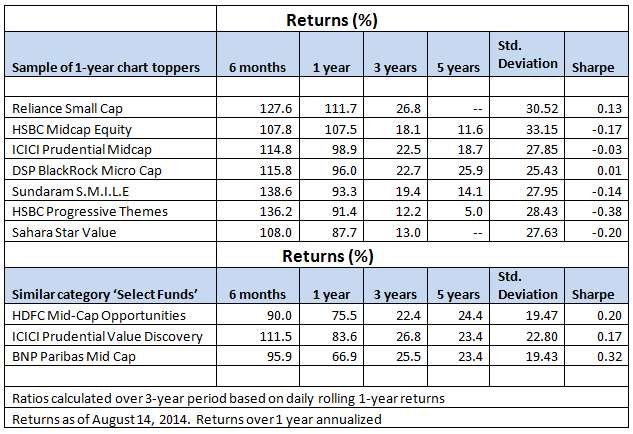Often times, when you (our investors) interact with our advisors on the choice of funds for your portfolio, or you try to choose a fund yourself from our ‘Select Funds’ list, the most popular question is: ‘X’ equity fund has better one-year returns. Why is it not being recommended?
This week, we’d like to provide our views on this key question as this often drives the choice of your equity funds.
The One-year Return Game
With markets running up sharply post September 2013, the difference in the performance of funds can be quite stark, especially when you look at their one-year return. Hence, it is very easy for you to get carried away by returns, at this point in time, without knowing the ‘why’ while not being sure whether such performance can be sustained.
If you are looking at fund performance to invest now, you may be enamoured by the 100%-plus returns charted by some of the funds. But if you are choosing a fund merely based on this, we would caution you.
Let us take an example of HSBC Midcap Equity Fund. It delivered a whopping 108% returns in the past year. That’s far higher than the 73% category (midcap) average. But then, the first question you need to ask yourself is whether the fund has done well across several market phases, or is it a sudden shoot to fame? Why have the other funds with established records not delivered as much? And lastly, are these kinds of returns sustainable?
Why the outperformance: In market upswings such as the present one, stocks that have been languishing for long see a sudden spurt. Sometimes, when mid or small cap funds are stuck with such stocks, such a market momentum provides not only relief to the otherwise comatose portfolio, but also pushes NAV sharply as stocks jump.
Fund houses often use such rallies to also exit some stocks. This can be one reason for a sudden jump in a portfolio performance. Such a move does not in any way guarantee similar performance in the future.
The difference: If you take the fund given above as an example, you will see that it severely underperformed, falling as much as 66% in down markets such as 2008, and delivered a negative 44% in 2011. On the other hand, funds such as IDFC Premier Equity, which you may not see in the 1-year chart buster list, fell 53% and 18% in the above years. As a result, if you look at a 5-year record, the HSBC fund would have delivered a mere 11% annually, whereas IDFC Premier Equity managed 21% compounded annually.
In other words, consistency of performance scores over the flash-in-the-pan show.
Sustainability: In rallies such as the present one, if you enter a fund (or for that matter, enter equities) believing that the extraordinary one-year performance will repeat in the future, you may well be in for a disappointment.
And if you choose the wrong funds, the disappointment may be compounded as it is quite possible that such a fund will slip back to its mediocre ways of performance. Unless you look at longer periods of performance, the question of sustainability will not be answered.

The table above provides some equity funds, mostly from the midcap space, that topped the 1-year chart. Take a look at their longer-term returns and also their deviation and risk-adjusted ratios. You will see why the sample of ‘Select Funds’ we have given score easily over the longer term in terms of returns and other metrics as well.
So, if 1-year return is not a reliable factor to look, on what basis do we choose funds for you? Do look out for our next week’s mail (and our blog) to know what factors go into building our ‘Select Funds’ list.
Disclaimer: Returns mentioned are past returns and are not indicative of future performance.
To know how to read our weekly fund reviews, please click here.








Another well-explained article focusing on a temptation most investors succumb to!
Well-explained. Thanks for the timely article.
Also points-to-note:
[1] upswings like these skew up the 3-yr and 5-yr CAGR numbers too. So, we need to look at per-year gains, for each of the past 3-5 years.
[2] In general, equity MFs being long-term focus, we need to look at 7-yr and 10-yr earnings numbers too.
I see most of the sites do not present this info.
Well-explained. Thanks for the timely article.
Also points-to-note:
[1] upswings like these skew up the 3-yr and 5-yr CAGR numbers too. So, we need to look at per-year gains, for each of the past 3-5 years.
[2] In general, equity MFs being long-term focus, we need to look at 7-yr and 10-yr earnings numbers too.
I see most of the sites do not present this info.
Another well-explained article focusing on a temptation most investors succumb to!